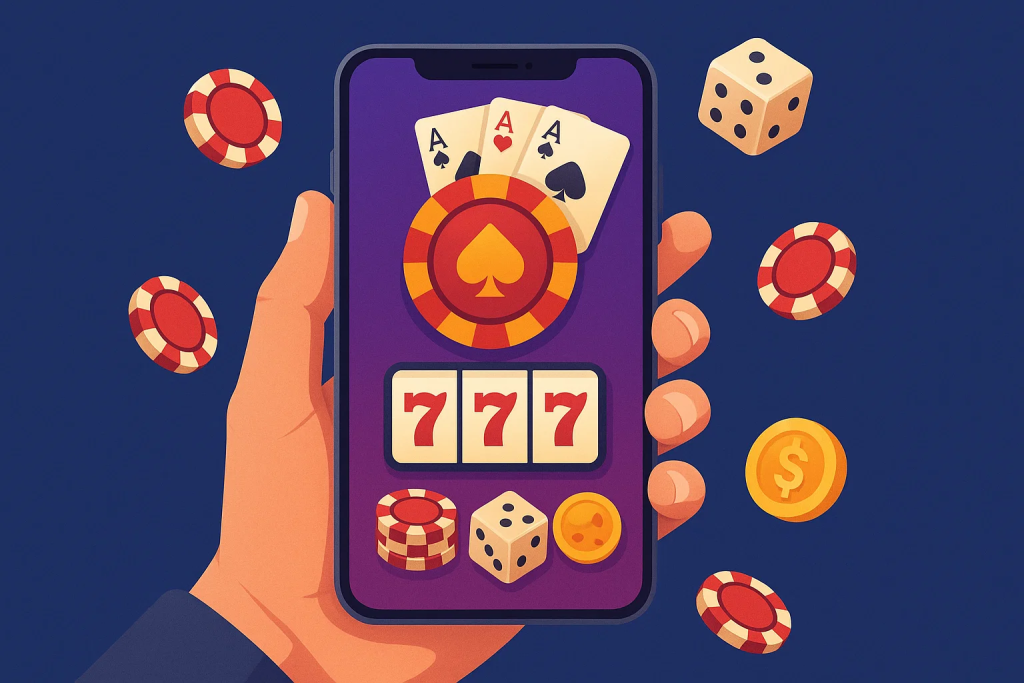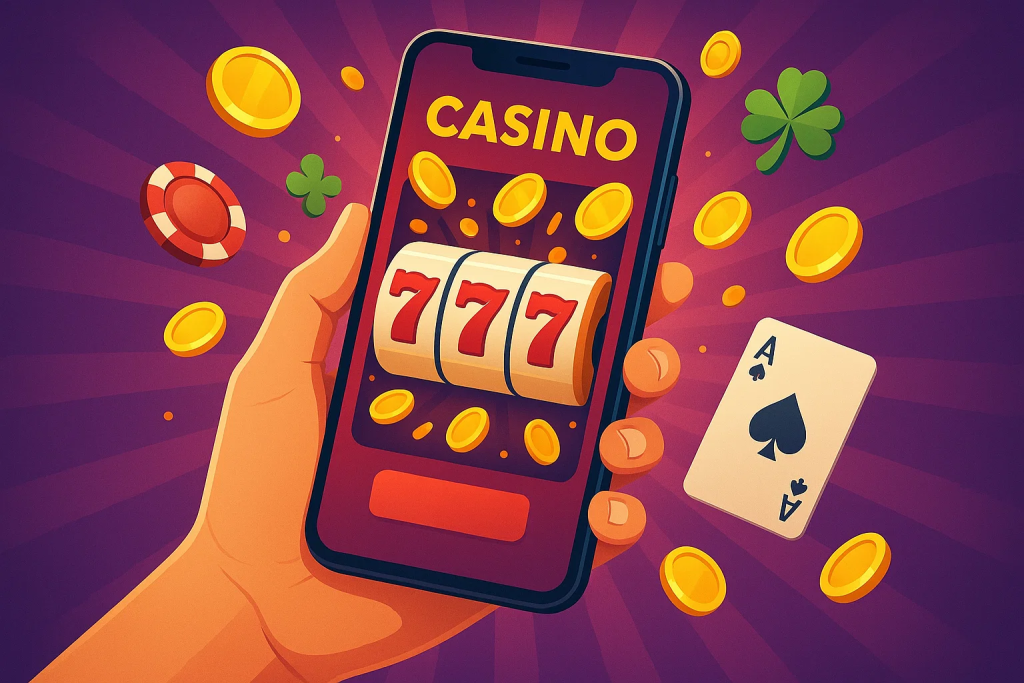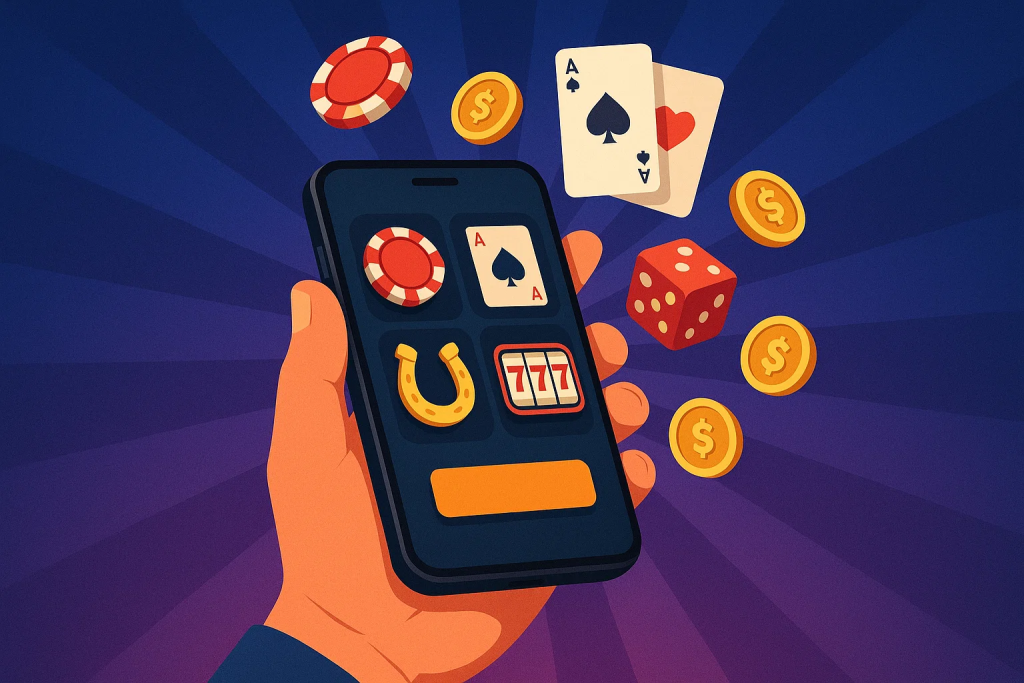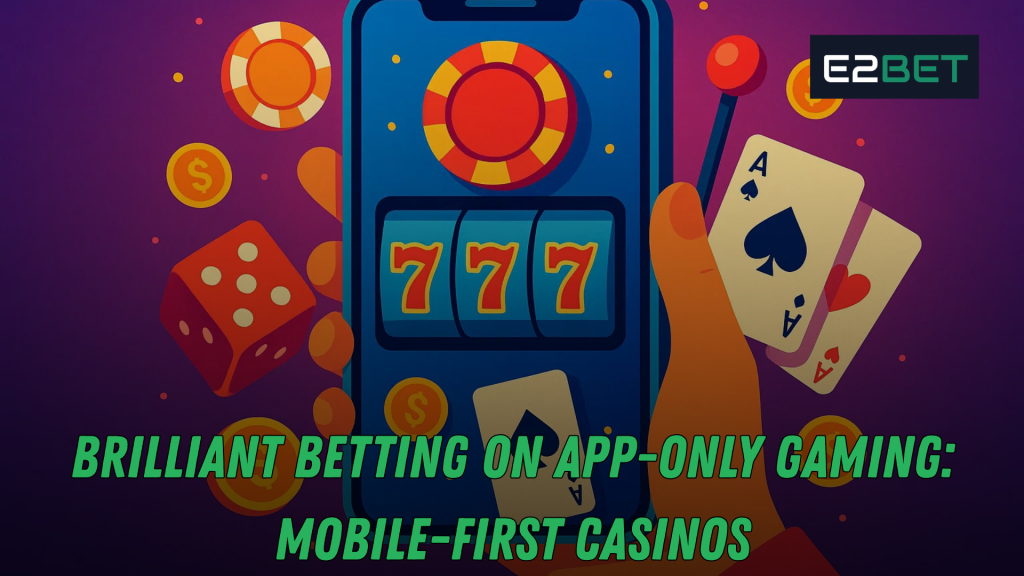Table of Contents
Executive Summary
App-Only Casinos are no longer buildings first and websites second; today the center of gravity lives in the pocket. A mobile-native approach delivers faster funnels, safer identity, and a more personal lobby for players who live on their phones. This long-form playbook shows operators, studios, and marketers how to design, launch, and scale a regulation-ready business model around app-only gaming without sacrificing ethics, accessibility, or long-term profits. By the end, you will have a blueprint you can run in the real world—covering product, growth, technology, compliance, and care—along with checklists and a 120-day plan.

What “mobile-first” really means
Mobile-first is not a shrunk desktop. It is a ground-up product philosophy that assumes one-handed play, intermittent connectivity, and sessions that happen in brief micro-moments. When the core loop is built for app-only gaming, navigation is thumb-native, the cashier is one gesture away, and every screen presents exactly one meaningful next step. The result is shorter time to fun, lower abandon rates, and a cleaner record of consent, which matters to regulators and players alike.
Principles that separate winners
- Zero dead ends: Every surface suggests a safe, useful action.
- Single-thumb paths: Primary calls-to-action live inside comfortable reach zones.
- Progressive disclosure: Advanced options exist, but only appear when needed.
- Snackable sessions: Games resolve in minutes; tournaments reset daily; live ops breathe hourly.
- Accessible by default: Large type options, screen-reader labels, and high-contrast palettes are built in, not bolted on—vital for app-only gaming at scale.
Why the shift is permanent
Three structural forces drive the migration. First, phones now feature 5G, high-refresh screens, and chips that run on-device inference for recommendations. Second, identity is safer with biometrics and device binding; payments are faster with tokenized wallets and open banking. Third, attention has moved to pushable surfaces like lock-screen widgets. All three converge to make app-only gaming a durable advantage, not a fad.
Business model in one view
A mobile casino grows on five pillars: acquisition, activation, monetization, retention, and responsibility. Acquisition comes from app store optimization, creator partnerships, and affiliates. Activation centers on 60-second KYC, instant limits, and a “first deposit streak.” Monetization mixes slots, crash games, live dealers, and quick prediction markets tuned for app-only gaming behavior. Retention uses streak mechanics, collection systems, and seasonal events. Responsibility threads through everything: reality checks, cooling-off timers, affordability checks, and one-tap self-exclusion.
UX patterns that convert without feeling pushy
You earn trust by respecting time. In the first 90 seconds, a new user should see the lobby, try a demo, finish KYC, and fund with a safe default amount. Micro-copy stays short, honest, and friendly. Haptic cues are optional and subtle. A sticky “mini-bank” shows balance changes in real time. Most importantly, the bet slip and the cashier both include visible limits, which keeps app-only gaming sustainable instead of extractive.
A thumb-native lobby
- Quick-bet ribbon: Favorite wagers sit in a horizontal strip for one-handed play.
- Live tile stack: Prioritizes tables or jackpots a player actually enjoys.
- Contextual help: A floating “?” explains odds, volatility, and payout math without leaving the flow.
- Session snapshots: A clock plus spend meter makes time and money tangible—design that protects app-only gaming from burnout.
Onboarding that respects rules and nerves
The best KYC flows feel like friendly checkouts. Use a three-step ring: ID scan, liveness, address. Show exactly what happens next and why. Where legal, allow demo mode while verification completes. Pre-select conservative deposit defaults and prompt players to set time, spend, and loss limits before their first real wager. When limits are part of the welcome, players internalize that app-only gaming is entertainment with boundaries.
Payments that build lifetime value
Deposits decide whether users ever become customers; withdrawals decide whether they stay. Support tokenized cards, Apple/Google Pay, local wallets, and instant bank rails. Publish clear withdrawal SLAs in-app and send proactive push updates. If a payment fails, offer alternatives; do not dead-end. Build affordability checks that are humane: ask, explain, and escalate to people when risk flags persist. Doing payments right is how app-only gaming earns five-star reviews and repeat visits.
Security, privacy, and licensing
Licensing bodies want proof you protect people and money. Bind sessions to devices, require biometric sign-in with explicit consent, encrypt everything with modern ciphers, and store keys in HSMs. Maintain immutable logs for transactions, bonuses, and responsible-gaming interventions. Practice regular red-team drills and share summaries with regulators. Treat privacy as a product feature; when players sense respect, they treat app-only gaming as a trusted ritual rather than a guilty secret.
Personalization that helps, not hounds
Recommendations should guide, not goad. Warm-start profiles by asking players to choose favorite themes and volatility. Use context to steer toward lower-risk modes after losing streaks, and toward tutorials after idle periods. Explain suggestions with human language: “Because you enjoyed low-volatility slots last week.” This style of transparency raises click-through while keeping app-only gaming humane.
Live ops: heartbeat of daily revenue
Live operations turn a static app into a living world. Run time-boxed tournaments that fit a commute. Offer season passes with cosmetic rewards and responsible caps. Reskin the lobby for holidays without bloating the build. Use server-driven UIs so events change without app updates. Treat live ops as a craft and app-only gaming becomes a daily habit rather than a quarterly curiosity.
Marketing stack and creator strategy
Traffic comes from stories people want to share. Test multiple icons and screenshots; show one-hand controls and in-app limits to build trust. Work with creators who disclose sponsorships and use safe streaming overlays with delay toggles. Build lifecycle messages that feel like service: welcome sequences, milestone congratulations, and gentle win-backs. Remember that great marketing simply narrates great product; if you respect players first, app-only gaming markets itself.
Responsible gaming by design
A healthy business grows by protecting customers, not exhausting them. Put limits on the bet slip and in the wallet; never bury them in settings. Add reality checks at sensible intervals with friendly tone. Detect patterns that signal risk—rapid bet escalation, overnight binges, repeated failed top-ups—and intervene with friction or human outreach. Offer one-tap cool-offs and self-exclusion with resource links. Responsible design is how app-only gaming stays on the right side of history.
The technology you actually need
Front ends should be Swift/Kotlin with accessibility first. Back ends should separate auth, wallet, catalog, RNG, and bonus engines behind an event bus. Telemetry should stream to real-time dashboards. Use feature flags and staged rollouts so experiments do not break production. Add observability—traces, metrics, and logs—so engineers can fix issues before players notice. A calm stack lets teams ship fast without making app-only gaming feel flaky.
120-day launch plan (copy and run)
Days 1–30: Foundations
Map regulations, pick payment rails, design the two core loops (slots + live table), and write your responsible-gaming charter. Recruit a small guardrail council—legal, security, and care—that can approve changes quickly. Draft your brand’s voice: friendly, precise, and honest about odds. Align every stakeholder that this will be a focused pilot for app-only gaming in one market.
Days 31–60: Build
Integrate KYC, wallet, bonus engine, and the first five games. Implement push notifications, deep links, and a simple event system. Instrument the funnel: install → permissions → KYC → deposit → first bet. Wire limits into the bet slip and cashier. Prepare creator kits with disclosure guidance. Finish ASO assets that show exactly how app-only gaming feels in one hand.
Days 61–90: Soft launch
Release in one region, cap marketing spend, and meet daily to review dashboards. Run two ASO experiments per week and a single live-ops event per day. Publish your withdrawal SLA, then hit it. Share a transparent responsible-gaming page in-app. Invite early players into a feedback channel and ship fixes in 48 hours. The goal is simple: prove retention and trust for app-only gaming before scale.
Days 91–120: Scale
Add content, turn on affiliates, and expand support hours. Optimize deposit and withdrawal funnels. Publish a monthly transparency report: limits set, cool-offs taken, interventions resolved. Localize copy for holidays. Lock a quarterly roadmap that adds features players actually request. If you can scale while keeping response times low and safety measures visible, app-only gaming becomes your moat.
KPIs that really matter
Track five boards that fit on one screen. The Funnel Board covers install-to-KYC, KYC-to-deposit, and time to first bet. The Engagement Board watches sessions per day, time in game, and feature adoption. The Economy Board tracks bonus liability, payback windows, and ARPDAU. The Care Board measures limit adoption, cool-off usage, and response times. The ASO Board follows impression-to-install rates and keyword ranks. If a metric does not change behavior, drop it; focus on signals that you can improve in a week.
Pitfalls—and quick fixes
- Desktop habits on mobile: Audit thumb reach and rewrite flows for single-hand use.
- Over-bonusing: Replace blanket promos with milestone paths and season passes.
- Slow withdrawals: Automate checks, display timelines, and push updates.
- Ignoring accessibility: Add scalable text, captions, and color-safe palettes.
- Treating care as optics: Surface limits where decisions happen. The fix is not hard; the discipline is. When limits live on the bet slip, app-only gaming earns long-term loyalty.
Monetization with a conscience
You can grow revenue and keep dignity. Disclose RTPs in plain language. Offer session budgets that let players pre-commit cash and time; celebrate stopping on time. Build VIP programs around service, not pressure; run periodic affordability reviews. Add collection systems that reward consistent, moderate play. In the long run, trust compounding monthly is worth more than any single whale, and that is doubly true in app-only gaming where reviews and referrals drive installs.

Content strategy that scales without bloat
Balance familiarity and novelty. Anchor the lobby with reliable crowd-pleasers; rotate seasonal skins; introduce one new mechanic at a time. Localize art and audio with cultural care. Provide creator-friendly modes with spectator overlays. Stream assets on demand to keep the binary small. A nimble content pipeline lets app-only gaming ship “new” weekly without a 2-GB update that scares users off.
Analytics that change behavior
A minimal stack beats a complicated graveyard of dashboards. Run a daily 15-minute standup that picks one improvement, ships it, and measures the delta next day. Tie every experiment to a hypothesis about friction. Example: “Moving the deposit CTA into thumb reach will raise KYC-to-deposit by 10%.” Track, learn, keep or roll back. This rhythm turns app-only gaming into a compounding machine instead of a feature museum.
Organizational design for speed and safety
Structure teams around small trios—product, engineering, and design—owning features end-to-end. Guardrail guilds—legal, responsible gaming, and security—meet weekly to unblock rather than to veto. Give community managers real authority to moderate chats and educate streamers. Reward staff for preventing problems as much as for shipping features. Culture is the invisible API that makes app-only gaming feel effortless to build and effortless to use.
Imaginary snapshots to spark ideas
Case A: Wallet friction fix. A team moved the deposit CTA to thumb reach and added Apple/Google Pay. KYC-to-deposit conversion rose 19% in a week while support tickets fell.
Case B: Retention via reality checks. A friendly 30-minute timer with hydrate prompts reduced binge sessions and lifted D7 retention by six points, proving that care can grow revenue.
Case C: Live-ops ladder. A 20-minute daily tournament increased ARPDAU 11% without raising average bet size. Smart rhythm beats brute force, especially in app-only gaming where micro-moments rule.
The ethics of attention
The most honest pitch is simple: this is entertainment with odds. Your app should display clear chances, make raising limits harder than lowering them, and ask “Are you still okay?” at humane intervals. You are vying for a slice of human attention; treat it like a privilege, not quarry. Brands that speak plainly and keep promises earn the reviews and referrals that compound. That is how app-only gaming becomes a long-lived category, not a cautionary tale.
Regional compliance considerations
No serious operator scales without a licensing map. Start by grouping jurisdictions into green, amber, and red buckets. Green markets are those with clear statutes, predictable audit cycles, and known technical standards. Amber markets allow activity under provisional approvals or legacy laws but expect change; they demand conservative risk appetites and contingency plans. Red markets are those with explicit prohibitions or unstable regimes—launching there is a reputational hazard.
Across all buckets, document data residency, record retention, and reporting. Some regulators expect near-real-time event feeds for transactions and suspicious activity; others accept daily batches. Do not guess. Appoint a compliance lead with the authority to pause promotions or disable features when rules update. When in doubt, over-communicate. Regulators appreciate teams that flag issues early, fix them fast, and produce artifacts—meeting notes, test logs, and release diffs—whenever requested.
Build patiently, measure honestly, and treat players with care; sustainable growth follows teams who value clarity, dignity, and relentless iteration over shortcuts, always.
Accessibility and inclusion: design for everyone
The best mobile products welcome older eyes, shaky hands, screen readers, and low-end devices. Build scalable typography with a large-text toggle that does not break layouts. Add captions to promo videos and provide transcript links. Use color-blind-safe palettes and add texture to chips or tiles so wins and losses are visible even in grayscale. Test navigation with voice control and with one hand. Consider sensory load: flashing animations and aggressive sound effects can overwhelm some players. Offer calming themes, adjustable brightness, and granular audio sliders so every user can tailor the experience.
Inclusion also means financial comfort. Not every player can deposit at the most popular amounts. Provide micro-stakes tables, time-boxed events, and daily freebies that do not trick people into overspending. Make self-exclusion straightforward and respectful: no scolding language, just clarity, support links, and a clear path back only after cool-off windows. Healthy design choices will not kill revenue; they cultivate loyalty and guard the brand when headlines turn critical.
ASO and paid UA: precision beats volume
App store optimization begins with honest positioning. Your title, subtitle, and keywords should reflect what you truly offer. Screenshots should show the first minute of the experience, not cinematic scenes that never occur. Test icon styles—flat, 3D, mascot, or lettermark—and rotate winners into creative packages for ads. Maintain a seasonal storyboard so assets refresh with holidays without re-inventing your identity.
For user acquisition, pair broad creatives with precise audience filters. Use day-parting to avoid expensive hours and to concentrate spend where conversion is strongest. Hold weekly attribution reviews that compare platform-reported numbers with your own post-install events. When discrepancies grow, re-weight spend rather than arguing with dashboards. Above all, protect cohorts from spam: if someone just installed, do not drown them in email. Let the product speak for itself, then follow up with value—news about new tables, sensible bonuses, or content that teaches strategy without promising outcomes.
Future trends worth preparing for
Four shifts are on the horizon. First, passkeys and on-device verifiers will reduce friction and fraud; plan now to support password-less sign-ins. Second, thin-client streaming will bring higher-fidelity tables and slots to cheaper phones, but only if lobbies detect bandwidth and adapt gracefully. Third, privacy sandboxes will limit cross-app tracking; build first-party telemetry and cohort analytics so growth survives policy changes. Fourth, regulators are moving toward standardized affordability checks and clearer bonus disclosures—get ahead by designing these tools as first-class features, not last-minute patches.
Appendix: a one-page pre-launch checklist
- Legal: jurisdiction list, document templates, audit contacts, escalation paths.
- Security: key rotation plan, incident runbooks, and tabletop drills scheduled.
- Product: two core loops polished, limit controls visible, demo mode ready.
- Payments: at least three deposit methods and two withdrawal rails live.
- Data: five dashboards linked to daily standups; clear owners and thresholds.
- People: support team trained on empathy scripts and refund policies.
- Marketing: ASO assets tested, creator kits approved, disclosure language standard.
- Governance: monthly transparency report format ready; leadership aligned on what you will never do.

One last word: if you cannot explain a feature to a non-technical friend in two sentences, do not ship it. Clarity scales; confusion does not. That single principle will save months of rework and countless support tickets while keeping morale high on the way to launch.
Call to action
If you are planning a launch, pick one market, one audience, and one core loop. Ship a lovable version in 120 days, publish your safety plan, and measure like your license depends on it—because it does. Need help? Bring funnel numbers, a few screenshots, and your compliance checklist. Together we can prioritize a backlog that makes app-only gaming safer, faster, and more profitable without losing your soul.
Frequently Asked Questions (FAQ)
1) Do I have to be app-only, or can I keep the website?
You can keep both, but leading with the app improves speed, permissions, push messaging, and identity security. Many operators keep a lightweight web presence for support and SEO while concentrating play where app-only gaming shines.
2) What is the #1 onboarding change to try first?
Shorten KYC to a three-step ring and allow demo mode while checks complete where legal. That single change can lift activation rates and reduce anxiety for newcomers to app-only gaming.
3) How do I scale content without bloating the app?
Use server catalogs, modular downloads, and texture compression. Load the lobby fast, then stream assets on demand. This keeps installs lean and updates painless—best practice for app-only gaming.
4) Will stronger responsible-gaming tools hurt revenue?
In the short term you may see fewer extreme sessions. Long term, healthier behaviors raise trust, retention, and LTV—net positive for any brand built on app-only gaming.
5) Which KPIs should leadership check weekly?
Install-to-KYC, KYC-to-deposit, time to first bet, D7 retention, ARPDAU, and limit adoption. If those six are healthy, your app-only gaming operation is likely on track.
